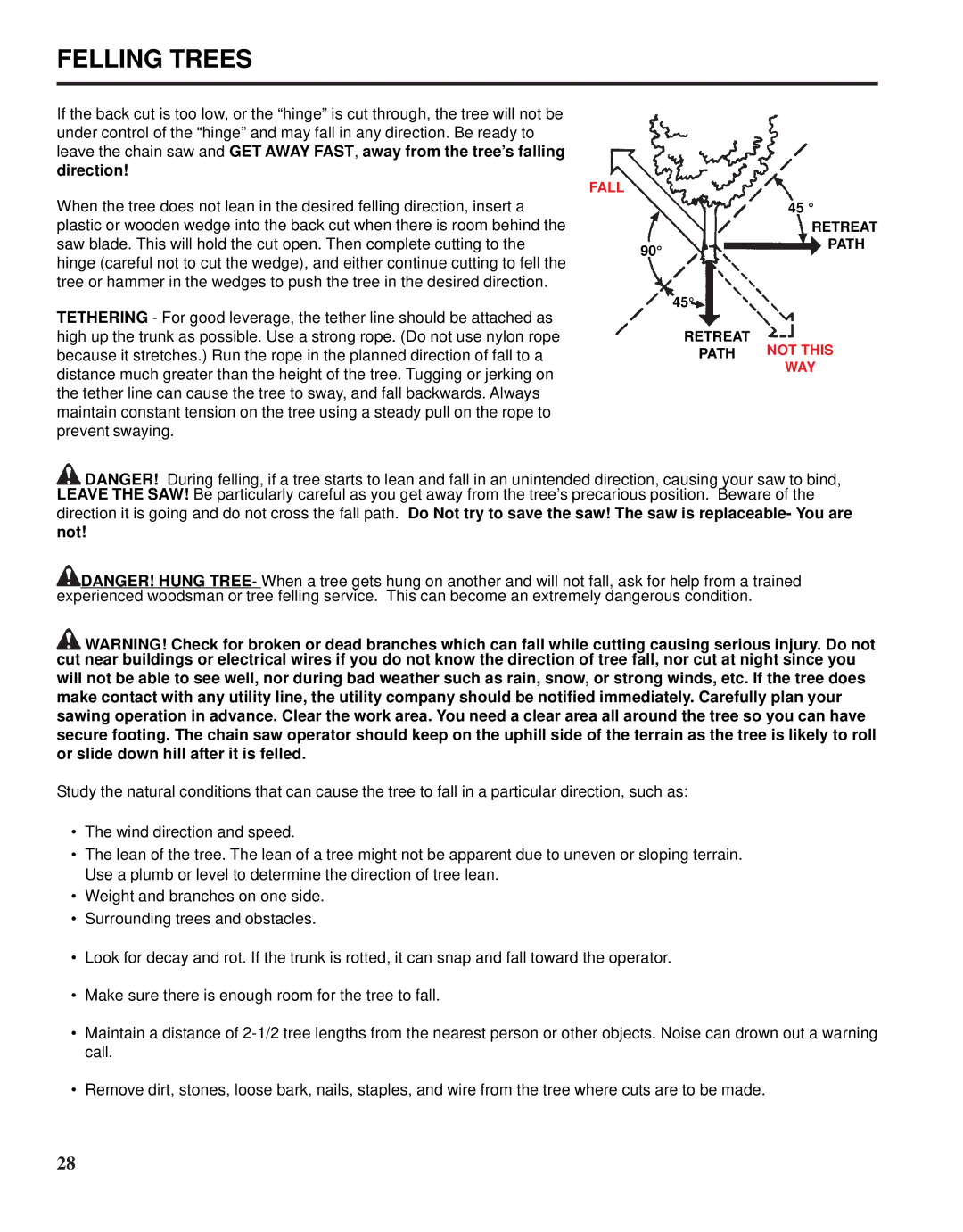
FELLING TREES
If the back cut is too low, or the “hinge” is cut through, the tree will not be under control of the “hinge” and may fall in any direction. Be ready to leave the chain saw and GET AWAY FAST, away from the tree’s falling direction!
When the tree does not lean in the desired felling direction, insert a | FALL |
|
| 45 ° | |
plastic or wooden wedge into the back cut when there is room behind the |
| RETREAT |
saw blade. This will hold the cut open. Then complete cutting to the | 90° | PATH |
hinge (careful not to cut the wedge), and either continue cutting to fell the |
| |
|
| |
tree or hammer in the wedges to push the tree in the desired direction. |
|
|
TETHERING - For good leverage, the tether line should be attached as high up the trunk as possible. Use a strong rope. (Do not use nylon rope because it stretches.) Run the rope in the planned direction of fall to a distance much greater than the height of the tree. Tugging or jerking on the tether line can cause the tree to sway, and fall backwards. Always maintain constant tension on the tree using a steady pull on the rope to prevent swaying.
45°
RETREAT
PATH NOT THIS WAY
![]() DANGER! During felling, if a tree starts to lean and fall in an unintended direction, causing your saw to bind, LEAVE THE SAW! Be particularly careful as you get away from the tree’s precarious position. Beware of the direction it is going and do not cross the fall path. Do Not try to save the saw! The saw is replaceable- You are not!
DANGER! During felling, if a tree starts to lean and fall in an unintended direction, causing your saw to bind, LEAVE THE SAW! Be particularly careful as you get away from the tree’s precarious position. Beware of the direction it is going and do not cross the fall path. Do Not try to save the saw! The saw is replaceable- You are not!
![]() DANGER! HUNG TREE- When a tree gets hung on another and will not fall, ask for help from a trained experienced woodsman or tree felling service. This can become an extremely dangerous condition.
DANGER! HUNG TREE- When a tree gets hung on another and will not fall, ask for help from a trained experienced woodsman or tree felling service. This can become an extremely dangerous condition.
![]() WARNING! Check for broken or dead branches which can fall while cutting causing serious injury. Do not cut near buildings or electrical wires if you do not know the direction of tree fall, nor cut at night since you will not be able to see well, nor during bad weather such as rain, snow, or strong winds, etc. If the tree does make contact with any utility line, the utility company should be notified immediately. Carefully plan your sawing operation in advance. Clear the work area. You need a clear area all around the tree so you can have secure footing. The chain saw operator should keep on the uphill side of the terrain as the tree is likely to roll or slide down hill after it is felled.
WARNING! Check for broken or dead branches which can fall while cutting causing serious injury. Do not cut near buildings or electrical wires if you do not know the direction of tree fall, nor cut at night since you will not be able to see well, nor during bad weather such as rain, snow, or strong winds, etc. If the tree does make contact with any utility line, the utility company should be notified immediately. Carefully plan your sawing operation in advance. Clear the work area. You need a clear area all around the tree so you can have secure footing. The chain saw operator should keep on the uphill side of the terrain as the tree is likely to roll or slide down hill after it is felled.
Study the natural conditions that can cause the tree to fall in a particular direction, such as:
•The wind direction and speed.
•The lean of the tree. The lean of a tree might not be apparent due to uneven or sloping terrain. Use a plumb or level to determine the direction of tree lean.
•Weight and branches on one side.
•Surrounding trees and obstacles.
•Look for decay and rot. If the trunk is rotted, it can snap and fall toward the operator.
•Make sure there is enough room for the tree to fall.
•Maintain a distance of
•Remove dirt, stones, loose bark, nails, staples, and wire from the tree where cuts are to be made.
28
